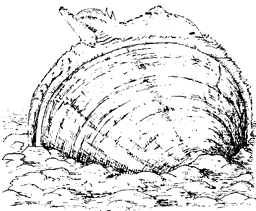 |
Science Frontiers ONLINE No. 85: Jan-Feb 1993 |
|
|
The Lures Of Mussels
Mussels entrust their larvae to the vagaries of the waters in which they live. How, then, are mussels ever able to colonize rivers, whose currents would always sweep their larvae downstream?
 A pseudofish with tail, fins, and eye spot displayed by a mussel. |
"The riverine pioneers ran this roadblock by custom designing their baby mussels to hitchhike on fish. Kneehigh to a pinhead, the larval mussel, or glochidium, is nurtured by the thousands or millions in their mother's gills, and spewed in teeming puffs to the open waters. They cling as benign parasites to passing fish, and take a one- to three-week trip, drawing nutrients through their host's membranes and a free ride to new dwellings. They then drop to the bottom and begin their independent lives, some of which will span a half century or more."Glochidia that do not hook up with a host fish are doomed. To cover these stakes, the pocketbook mussel and its relatives have evolved a fleshy appendage that flaps in the currents and, to a smallmouth bass, looks like a breakfast minnow. Taking the bait. the duped fish gets doused with glochidia. Another resourceful mussel sends its glochidia out in pulsating little packets resembling worms."
(Stolzenburg, William; "The Mussels' Message," Nature Conservancy, p. 17, November/December 1992.)